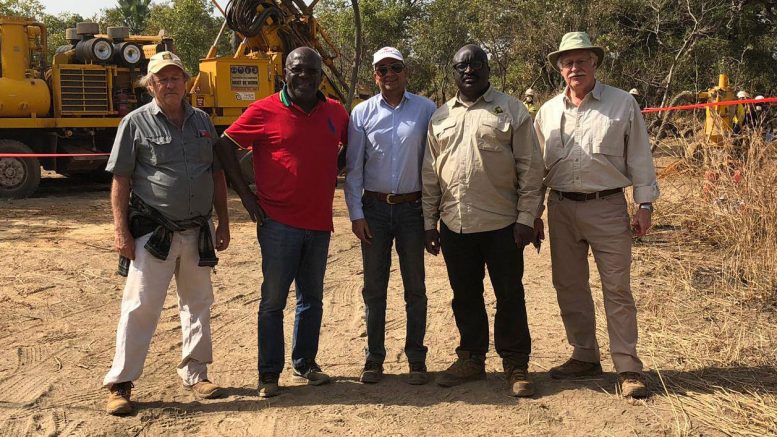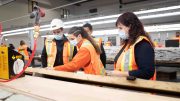Since acquiring the Kandiole project in Mali three years ago, Roscan Gold (TSXV: ROS; US-OTC: RCGCF) has served up some of the best drill intercepts in West Africa and made significant discoveries on its large land package, about 25 km east of B2Gold’s (TSX: BTO; NYSE-AM: BTG) producing Fekola mine.
The Kandiole project, about 400 km west of Mali’s capital Bamako, is situated in the Birimian Greenstone Belt, one of Africa’s most productive regions, and is within trucking distance of Iamgold’s (TSX: IMG; NYSE: IAG) Boto and Diakha deposits.
The company tripled its 2020 drill program from 10,000 metres to 30,000 metres in February, and raised it to 45,000 metres in mid-June. In August it added a fifth drill rig. In addition to its aggressive drill program, Roscan has analyzed termite and soil geochemistry as well as completed airborne geophysical surveys.
In the last three months, Roscan has made three new discoveries: Kandiole North, about 10 km from its flagship target Mankouke South; Mousalla North, about 8 km northeast of Kandiole North; and Walia, about 15 km from Kandiole North. Walia is situated on the Komet Mali ground that the company picked up in July when it acquired Komet Mali from Komet Resources (TSXV: BRW). Komet Mali owns the Dabia South project, about 35 sq. km of ground located between the Kandiole project and Oklo Resources’ (ASX: OKU) Dandoko project.
Drill results from Kandiole North included 53.6 grams gold over 2 metres from 14 metres downhole; 24 grams gold over 2 metres from 10 metres’ and 8.76 grams gold over 4 metres starting from 7 metres. Assays from the Mousalla North discovery included 5.39 grams gold over 32 metres from surface; and 1.90 grams gold over 10 metres from 18 metres, while highlights from Walia included 21.4 grams gold over 8 metres from 26 metres downhole; 11.4 grams gold over 2 metres from surface; and 7.96 grams gold over 2 metres from 2 metres.

Soil sampling at the Kandiole site in Mali in 2017. Credit: Roscan Gold.
The intense exploration program, which even continued during the rainy season that runs from mid-July until early October, was driven in part by the importance of fleshing out as many of its targets as possible before six confidentiality agreements the company has signed expire at the end of next year. Drills are turning around the clock in two shifts.
“We should be in resource delineation mode for the most part of next year,” Nana Sangmuah, Roscan’s president and CEO, said in an interview, noting that the company plans to complete an initial resource estimate before the end of 2021. “We’re generating a lot of news flow this year with target generation and there will be tons of news flow leading up to the end of the year and into next year. And as the target prioritization exercise is completed, that will set the stage for a more aggressive drill campaign for 2021.”
In addition to the resource work, the company must continue to do generative work. “For exploration companies to be successful, your resource triangle should be robust,” Sangmuah said. “Why this is going to be relatively easy for a junior of our stature is that we’ve done a lot of drilling already on the ground so we have a lot of pierce points in areas where geophysics are going to run; we also have several outcrops; we have some geochem; and are going to put all that information into a 3D target generation model.”
Sangmuah expects the company will complete the 45,000 metre drill program well before the end of 2020 and could add more metres as necessary to the work program.
Drill results from 16 holes at its flagship Mankouke South target reported on Nov. 23 included 5.35 grams gold over 53 metres from 126.5 metres downhole, including 12 metres of 12.5 grams gold; 13.9 grams gold over 6 metres from 53.5 metres downhole; and 3.99 grams gold over 17 metres starting from 166.3 metres downhole. Roscan discovered Mankouke South in July 2019 and the company’s work program there has returned high grade intercepts along 700 metres of strike and to a vertical depth of 178 metres. The target remains open to the north, west and at depth.
Sangmuah noted that the company is confident that the feed source of the hydrothermal alterations at Mankouke South should culminate in tracing a big system “analogous to some of the known large deposits in the region with similar lithological controls.”
Prior to joining Roscan as CEO in December 2019, Sangmuah, a mining engineer by training, had worked as managing director of equity research at Clarus Securities, and in that capacity knew Roscan’s founder Greg Isenor; was familiar with his track record in West Africa; and was aware of Roscan’s Kandiole project.
“Greg has a very good nose for finding ground and all his targets have been picked up by majors and I thought this was a very good company,” Sangmuah said of his decision to join the team. Isenor was president of Merrex Gold from 2005 until 2017, during which time the company discovered the Siribaya deposit in Mali. It also discovered the Diakha deposit with joint-venture partner Iamgold, which acquired Merrex in 2017. Prior to Merrex, Isenor had been CEO of Jilbey Gold Exploration Ltd., where he led the team that identified the Bissa gold deposit in Burkina Faso, which was later acquired by High River Gold Mines and put into production by Nordgold.
“As an analyst you oftentimes come across very undervalued situations and good opportunities that the market is not really paying attention to,” Sangmuah said. “I thought I’d give him two years or 18 months to figure out what’s on this and then we could start sinking our teeth into it, but within six months they had some very good results from Central Mankouke. At the time, Roscan was trading at a quarter of the valuation of Oklo Resources, and all of them were playing in the same sandbox with similar rocks. So it was a no-brainer … it was a very compelling proposition … and an offer I couldn’t refuse.”
Drill highlights from Roscan’s Mankouke Central target (about 5-6 km from Manouke South) have included 14 metres grading 8.68 grams gold starting from 10 metres downhole; 18 metres of 8.47 grams gold starting from 26 metres; and 14 metres of 5.94 grams gold from surface.

Sampling a termite mound at the Kandiole site in Mali. Credit: Roscan Gold.
After joining Roscan, Sangmuah brought in Samuel Jonah as the company’s non-executive chairman. Jonah joined Ashanti Goldfields in 1979 and at the age of 36 became its CEO. Over ten years, Jonah and his team increased the company’s gold production from 240,000 oz. a year to 1.6 million ounces, and oversaw the company’s listing on the New York Stock Exchange. In May 2004, after Ashanti merged with AngloGold, Jonah became the company’s executive president.
“Jonah is noted for building junior companies into multi-million market cap companies and he was also looking for an opportunity in the mining space and he was very keen and came to site the very next day after joining the board and walked the targets and was thrilled,” Sangmuah said.
Sangmuah also hired David Reading in April as a technical consultant. Reading, the former CEO of European Goldfields and Aureus Mining, also worked as general manager of African exploration in the early days at Randgold Resources. In addition, Reading served as a special advisor to Continental Gold until its sale earlier this year to China’s Zijin Mining for $1.4 billion.
“We have got quite a good pool of talent within a small company and it has really helped crystallize solid growth for us within the last few months and we’re hoping to build on that,” Sangmuah said.
Management and directors own about 12% of the company’s common shares outstanding.
Over the last year Roscan has traded in a range of 10¢ and 55¢ and at presstime was trading at 39¢. The junior explorer has about 265 million common shares outstanding for a market cap of about $106 million.



Be the first to comment on "Roscan Gold advances Kandiole project in Mali"